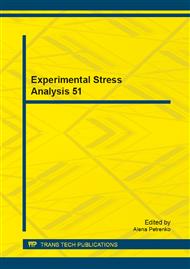p.32
p.36
p.42
p.48
p.54
p.58
p.62
p.66
p.72
An Effect of Surface Laser Hardening on Deformations and Fatigue Properties of 42CrMo4 Steel Specimens
Abstract:
Laser hardening is an advanced method of surface heat treatment with wide possibilities of industrial applications. Considering the fact that this technology is fairly new and is being developed, knowledge about effects on properties of materials treated by this technology are still limited, particularly from the viewpoint of mechanical and particularly fatigue properties. As a dependence of numerous parameters of the treatment, basic material and its state and also size of treated pieces or specimens, not only substantial changes of microstructure in the surface and subsurface layers occur, but also residual stresses and connected deformations. Results of an experimental investigation of effects of laser treatment with selected parameters on deformations and fatigue resistance of relatively small samples of 8 x 8 mm cross section are presented and discussed in this work. Effects of surface speed of the laser beam was evaluated, then effects of fixation of the specimens to rigid supporting steel plate on changes of deflection caused by the laser treatment and eventually, changes of the deformations after releasing the specimens from the supporting plate. Results are in a good agreement with residual stress measurements. Fatigue tests indicated possibilities of favourable effects of laser treatment on fatigue resistance. Results are discussed considering an occurrence of inclusions in the material, residual stresses and fatigue damage mechanisms.
Info:
Periodical:
Pages:
54-57
Citation:
Online since:
December 2013
Keywords:
Price:
Сopyright:
© 2014 Trans Tech Publications Ltd. All Rights Reserved
Share:
Citation:


